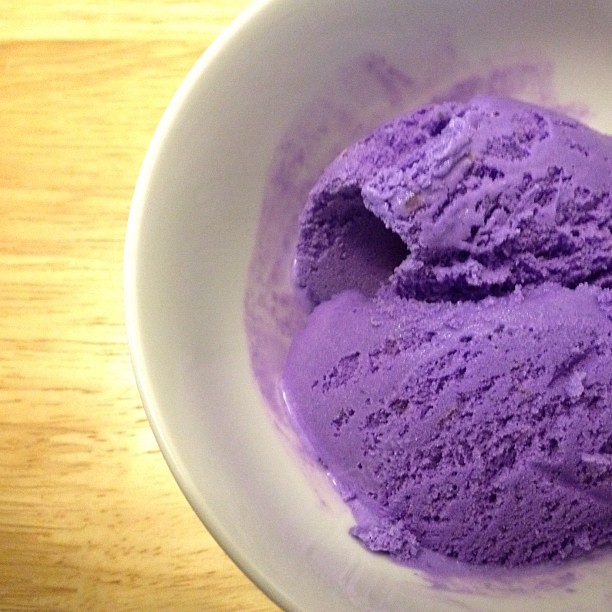Purple Yam Jam- Ube at It’s Finest!

It’s such a fun thing to me that even as an adult in my 30’s, I can still learn about new foods. I recently learned about ube, and it’s something I had never heard of before- but now I definitely want to get more familiar with it!
Ube is basically a purple potato! And when I say purple, I mean PURPLE. You don’t need food coloring to get a gorgeous purple color. It literally looks like a bright purple sweet potato. Just like your typical sweet potato, it actually has some great nutritional value. It’s high in fiber, as well as being a source of B vitamins, Vitamin C, calcium, iron, and Vitamin A. It’s also full of antioxidants to help fight inflammation. So overall a great little veggie to add to your arsenal!
It is well-loved and used in the Philippines, though it originated in Southeast Asia. You can also enjoy some ube-inspired foods in Hawaii. My sister visited the islands in April and raved about these delicious ube pancakes she and her husband enjoyed. She ended up buying an extract online to use for her sweet baby’s birthday. Her baby passed away 6 years ago, and purple is the color that reminds them of her. So they do all things purple on her birthday, and bright purple ube waffles totally fit the color scheme!
You can sometimes find ube fresh in the U.S (try your local Asian market!), but it’s probably easier to find it as a powder or frozen. The flavor is hard to describe, but picture a caramelly, nutty flavor. Though some compare it to coconut, and some compare it to vanilla! Maybe it depends on the particular ube you eat. Either way, it’s seriously so good! And it’s the perfect base for so many tasty foods! If you have a recipe that calls for pumpkin or sweet potato, try using ube instead!
A very common dish in the Philippines is Ube Halaya, or Purple Yam Jam. I’ve included it here below for your enjoyment!
Ube Halaya (Purple Yam Jam)

A condiment that's both a versatile ingredient and a dessert all on its own.
Serving size: 3
Calories per serving: 565
Ingredients:
Calories per serving: 565
1 (16-ounce) package frozen grated ube, , thawed
3/4 cup granulated sugar
1 (13 1/2-ounce) can coconut milk
4 tablespoons unsalted butter, cut into 1/2-inch cubes (see note)
1/4 teaspoon Diamond Crystal kosher salt ; for table salt, use half as much by volume
Directions:
In a 4-quart saucepan, heat ube over medium-high heat. Cook, stirring occasionally, until ube has started to deepen in color and any excess water has been cooked off, about 3 minutes.
Add sugar and coconut milk and stir to combine. Bring mixture to a boil, then lower heat to maintain a gentle simmer. Cook, stirring and scraping frequently to prevent the ube from sticking to the saucepan, until the mixture has thickened to a jammy consistency, about 30 minutes.
Add butter and salt and continue to cook until mixture is dark purple in color and has reduced to a viscous, paste-like consistency, about 15 minutes.
Transfer to a heatproof medium bowl and let cool completely, about 30 minutes. Cover and refrigerate until cold.
To thaw frozen ube, defrost in the refrigerator overnight. To use fresh ube, first wash it thoroughly, then cover with water and boil until tender, between 30 to 40 minutes. Peel off skin and cut into 1/2-inch cubes (make sure you have 16 ounces; 454g). In Step 2, use a potato masher or immersion blender to smooth it out when you’re cooking it. Fresh boiled ube can be frozen in an airtight container for up to 3 months; defrost before using.
Substituting vegan unsalted butter for unsalted butter by weight will make this vegan.
Make-Ahead and Storage
Ube halaya can be refrigerated in an airtight container for up to 2 weeks or frozen for up to 3 months.
Source: sseriouseats.com
Add sugar and coconut milk and stir to combine. Bring mixture to a boil, then lower heat to maintain a gentle simmer. Cook, stirring and scraping frequently to prevent the ube from sticking to the saucepan, until the mixture has thickened to a jammy consistency, about 30 minutes.
Add butter and salt and continue to cook until mixture is dark purple in color and has reduced to a viscous, paste-like consistency, about 15 minutes.
Transfer to a heatproof medium bowl and let cool completely, about 30 minutes. Cover and refrigerate until cold.
To thaw frozen ube, defrost in the refrigerator overnight. To use fresh ube, first wash it thoroughly, then cover with water and boil until tender, between 30 to 40 minutes. Peel off skin and cut into 1/2-inch cubes (make sure you have 16 ounces; 454g). In Step 2, use a potato masher or immersion blender to smooth it out when you’re cooking it. Fresh boiled ube can be frozen in an airtight container for up to 3 months; defrost before using.
Substituting vegan unsalted butter for unsalted butter by weight will make this vegan.
Make-Ahead and Storage
Ube halaya can be refrigerated in an airtight container for up to 2 weeks or frozen for up to 3 months.
Source: sseriouseats.com
Recipe formatted with the Cook'n Recipe Software from DVO Enterprises.
Have you ever tried ube? I’d love to hear what you think of it!
 Camille Hoffmann
Camille Hoffmann
Weekly Newsletter Contributor since 2014
Email the author! camille@dvo.com
Sources:
- https://www.seriouseats.com/ube-halaya-purple-yam-jam-5195583
- https://www.eatingwell.com/article/7835700/what-is-ube/
- https://www.womenshealthmag.com/food/a30608029/what-is-ube/
- https://www.flickr.com/photos/krysaia/6858473876
